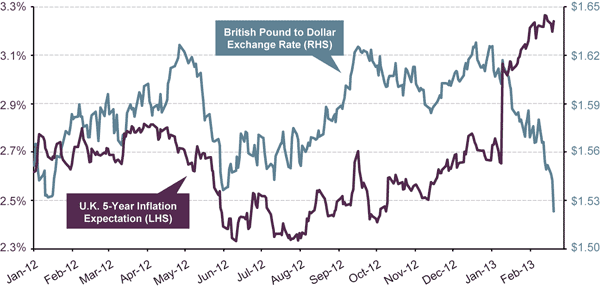by Scott Minerd
It appears as though the yen and the dollar will continue to fall relative to the euro for the time being. Although pursuing higher GDP growth through currency depreciation can have short-term benefits, such policy efforts rarely end without negative consequences. This is especially true when nearly all of the world’s major economies engage in such a race to the bottom. The buildup of pressure in the foreign exchange markets may evolve into a major issue for investors later in the year.
This is not the first time we have been through a period of currency market-induced volatility. As a result of the Plaza Accord of 1986, the dollar depreciated for nearly 21 consecutive months. This trend only ended when the Louvre Accord of 1987 attempted to stabilize currency markets by halting the dollar’s descent. During the period the dollar was plummeting, the U.S. economy roared and the stock market boomed. In time, however, the potential collapse of the dollar became an increasing concern, and inflation pressures mounted as input prices rose. In the second half of 1987, the Federal Reserve attempted to stave off further erosion of the dollar’s value by raising interest rates several times, which led to the stock market crash in October of that year. The scenario facing us today may evolve differently, but the net effect, namely higher volatility and upward pressure for asset prices in countries pursuing growth via devaluation, will likely be the same.
Economic Data Releases
Weak Housing and Production Data Not as Bad as Headline Numbers
• Housing starts declined 8.5% in January to an annual rate of 890,000, even as single family starts reached the highest pace since July 2008. Building permits posted a modest gain of 1.8%.
• The NAHB survey of homebuilder sentiment unexpectedly fell to 46 in February, the first decline since April.
• Industrial production shrank 0.1% in January, an unexpected contraction after two months of growth. The prior two months were revised up.
• Retail sales in January were weak as expected, up just 0.1%, managing to maintain growth for the third consecutive month.
• The Empire Manufacturing survey jumped to 10.04 in February, the best reading since May 2012.
• Business inventories ticked up 0.1% in December, the lowest since last June.
• Initial jobless claims fell by 27,000 to 341,000 for the week ended February 9th. The four-week moving average rose slightly to 352,500.
• University of Michigan consumer confidence rose to a three-month high of 76.3 in February.
• The producer price index increased 0.2% in January, the first rise in four months.
Eurozone GDP Down, However, Sentiment Positive
• Eurozone fourth quarter GDP shrank 0.6%, the largest decrease since the first quarter of 2009. The economies of Germany, France, and Italy all contracted more than expected, with growth rates of -0.6%, -0.3%, and -0.1%, respectively.
• Eurozone industrial production rose for the first time since August, increasing 0.7% in December.
• The German ZEW survey of economic sentiment, measuring expectations of growth, jumped to 48.2 in February from 31.5 a month earlier, reaching the highest level since April 2010. The INSEE French business confidence indicator also improved, rebounding to 90 in January, after falling in December.
• In the U.K., January retail sales fell 0.6% versus expected growth of 0.5%, the fourth month of decreasing sales. Jobless claims fell more than expected.
• In Japan, fourth quarter GDP unexpectedly posted negative growth for the third consecutive quarter, falling 0.1%.
• Japan’s exports rose for the first time in eight months, while imports rose higher, producing the largest trade deficit on record in January of ¥1.63 trillion.
Chart of the Week
The Carney Trade
Mark Carney, the incoming Governor for the Bank of England, has signaled his willingness to tolerate a higher inflation rate in exchange for faster economic growth. In anticipation of more aggressive monetary stimulus and potential inflationary concerns, investors are selling pounds and buying inflation-linked bonds. As a result, the British pound has depreciated sharply, while inflation expectations have risen. Since the start of the year, the pound sterling has risen 6.3% against the U.S. dollar, and the U.K. five-year expected inflation rate has surged 80 basis points.
U.K. 5-YEAR INFLATION EXPECTATION* VS. THE BRITISH POUND EXCHANGE RATE

Source: Bloomberg, Guggenheim Investments. Data as of 2/20/2013. *Note: The U.K. five-year inflation expectation is implied by the difference between five-year inflation-linked government bond yields and five-year nominal government bond yields.
This article is distributed for informational purposes only and should not be considered as investing advice or a recommendation of any particular security, strategy or investment product. This article contains opinions of the author but not necessarily those of Guggenheim Partners or its subsidiaries. The author’s opinions are subject to change without notice. Forward looking statements, estimates, and certain information contained herein are based upon proprietary and non-proprietary research and other sources. Information contained herein has been obtained from sources believed to be reliable, but are not assured as to accuracy. No part of this article may be reproduced in any form, or referred to in any other publication, without express written permission of Guggenheim Partners, LLC. ©2013, Guggenheim Partners. Past performance is not indicative of future results. There is neither representation nor warranty as to the current accuracy of, nor liability for, decisions based on such information.










